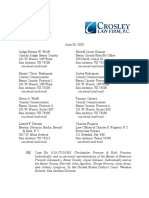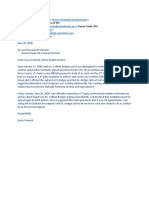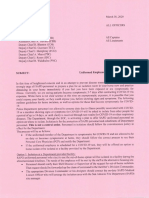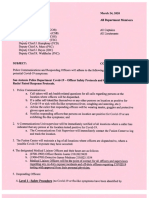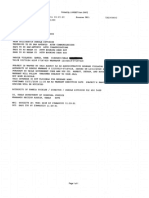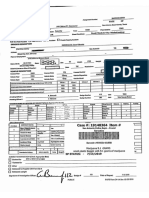Professional Documents
Culture Documents
June 2, 2014 - Wmaciated Baboon With Infected Trauma Wounds, Female Monkey With Degloved Tail
Uploaded by
Mariah Medina0 ratings0% found this document useful (0 votes)
53 views2 pagesJune 2, 2014 - Wmaciated Baboon With Infected Trauma Wounds, Female Monkey With Degloved Tail
Copyright
© © All Rights Reserved
Available Formats
PDF or read online from Scribd
Share this document
Did you find this document useful?
Is this content inappropriate?
Report this DocumentJune 2, 2014 - Wmaciated Baboon With Infected Trauma Wounds, Female Monkey With Degloved Tail
Copyright:
© All Rights Reserved
Available Formats
Download as PDF or read online from Scribd
0 ratings0% found this document useful (0 votes)
53 views2 pagesJune 2, 2014 - Wmaciated Baboon With Infected Trauma Wounds, Female Monkey With Degloved Tail
Uploaded by
Mariah MedinaJune 2, 2014 - Wmaciated Baboon With Infected Trauma Wounds, Female Monkey With Degloved Tail
Copyright:
© All Rights Reserved
Available Formats
Download as PDF or read online from Scribd
You are on page 1of 2
USDA United States Department of Agriculture
‘Animal and Plant Health Inspection Service anaet
isri40a35as0164 Insp ia
Inspection Report
‘Texas Biomedical Research Institute
P.O. Bax 760549 Customer ID: 1812
San Antonia, TX 78245 Centficate: 747-0003
Site: 001
TMWEST FOUNDATION FOR BKOMEDICAL RESEARCH
‘Type: ROUTINE INSPECTION
Date: Jun-02-2014
2.33 o 9
ATTENDING VETERINARIAN AND ADEQUATE VETERINARY CARE.
Records were reviewed for one young male baboon 40938. They state he died as a result of septicemia from trauma
wounds. Clinical records indicate that this animal had a clean health check and was in good body condition
aporoximately 3 weeks betore his death, At time of the health check on 10/28/13, the animal was relocated to a naw
enclosure which housed a large number of male baboons, Daily abservational logs during this time pertad donot
document an animal with wounds. Thay do not indicate any behavioral observation af the newly introduced animal for
agceptance into the group, The necropsy report siales the animal was emaciated at time of death and had multiple
scabs from bite wounds on the body and a large abscess on the leg and ankle, The description of the wounds and
body condition indicate that the animal had injuries for many days belore its-death. The animal received no care for
his injuries as it was not identified or reported to the veterinary staf.
Records were reviewed for an adult female chesus, 29458. This animal was placed in a newly formed group of
conspectics in building 14 in March 2013. Sometime prior io Sepiernber 2013 this animal suffered a tail de gloving
injury. On October 30, 2013 the animal was involved in.a second traumatic episode and susiained injuries that
included multiple lacerations to the face and body. 4 portion of the tall was alsa amputated during the altercation. A.
staff veterinarian stated during this inspection that the injuries were severe enough fo warrant assessment of the
foun by the facility behavior team. There is no documentation that any behavior assessment of the individual or
rou was pertarmed post injury
‘An adequate program of veterinary care includes daily observation of all animals to assess their health and well
boeing. Daily observation may be accomplished by someone other than the attending veterinarian, but here must be
direct and trequent communication so timely and accurate information on problems with animal health, behavior and
well - being is conveyed to the attending veterinarian
Newly introduced animals must be observed for adjustment issues and animals with trauma wounds must be
promptly identified and the behavior and vet staif promptly notified far intervention to provide adequate veterinary
care: to the animats,
CORRECT BY =6-10-14
Prepared By:
ELIZABETH PANNILL,D.V.M. USDA, APHIS, Animal Care Date:
Title: VETERINARY MEDICAL OFFICER Inspector 4018 Jun-08:2014
Received By:
Date:
Title: Jun-08-2014
Page fof 2
USDA United States Department of Agriculture counts
Animal ang Plant Health Inspection Service ssrisnassaspist ond
Inspection Report
2:36 o
ANNUAL REPORT.
REPEAT
‘The annual report submitted for 2019 does not accurately report the number af animals involved in studies that had
accompanying pain or distress that did not receive anesthetic, analgesics or tranquilizing drugs as the administration
of such would have adversaly atlacted the results of the project. One non human primate on protocol, 1327 GJ was:
improperly reported, The annual report must be amended and resubmitted to include an accurate count of the
number of animais attected.
‘The Inspection and exit briefing was conduced on June 2-4 2014 with the attending veterinarian and facility
employees.
pared
ELIZABETH PANNILL,D.V.M. USDA, APHIS, Animal Care Date:
Title: VETERINARY MEDICAL OFFICER Inspector 4018 Jun-08:2014
Received By:
Date:
Title: Jun-08-2014
Pops 21 2
You might also like
- Bribiescas LawsuitDocument14 pagesBribiescas LawsuitMariah MedinaNo ratings yet
- Kameron Prescott Demand LetterDocument16 pagesKameron Prescott Demand LetterMariah MedinaNo ratings yet
- Western District Court Injunction Mail Ballot Drop-Off Locations - October 9, 2020Document46 pagesWestern District Court Injunction Mail Ballot Drop-Off Locations - October 9, 2020The TexanNo ratings yet
- SAPD Officer Matthew Belver Arbitration Hearing Document PDFDocument31 pagesSAPD Officer Matthew Belver Arbitration Hearing Document PDFDavid IbanezNo ratings yet
- Dr. E To HR PDFDocument1 pageDr. E To HR PDFMariah MedinaNo ratings yet
- Judge Pitman OrderDocument15 pagesJudge Pitman OrderMariah MedinaNo ratings yet
- Dr. B To HR PDFDocument5 pagesDr. B To HR PDFMariah MedinaNo ratings yet
- Adjusting School CalendarsDocument24 pagesAdjusting School CalendarsMaritza NunezNo ratings yet
- Uniformed Employee Isolation GuideDocument3 pagesUniformed Employee Isolation GuideMariah MedinaNo ratings yet
- Southeast Nursing Home and Rehabilitation Center ResponseDocument3 pagesSoutheast Nursing Home and Rehabilitation Center ResponseMaritza NunezNo ratings yet
- Bexar County COVID Operating PlanDocument20 pagesBexar County COVID Operating PlanMariah MedinaNo ratings yet
- Stay Home Work Safe OrderDocument2 pagesStay Home Work Safe OrderMariah MedinaNo ratings yet
- Amanda Ferguson Internal Affairs Investigative ReportDocument4 pagesAmanda Ferguson Internal Affairs Investigative ReportMariah MedinaNo ratings yet
- Jennifer Loya ComplaintDocument12 pagesJennifer Loya ComplaintMariah MedinaNo ratings yet
- Amanda Ferguson Personnel FileDocument41 pagesAmanda Ferguson Personnel FileMariah MedinaNo ratings yet
- Search WarrantDocument24 pagesSearch WarrantMariah MedinaNo ratings yet
- COVID 19 Call ResponseDocument3 pagesCOVID 19 Call ResponseMariah MedinaNo ratings yet
- Parole Violation NoticeDocument1 pageParole Violation NoticeMariah MedinaNo ratings yet
- Second Baptist Church LawsuitDocument25 pagesSecond Baptist Church LawsuitMariah MedinaNo ratings yet
- TRODocument12 pagesTROMariah MedinaNo ratings yet
- Order Denying TRODocument3 pagesOrder Denying TROMariah MedinaNo ratings yet
- Motion To DismissDocument1 pageMotion To DismissMariah MedinaNo ratings yet
- Employee SurveyDocument29 pagesEmployee SurveyMariah Medina100% (1)
- Bail Reform LetterDocument3 pagesBail Reform LetterMariah MedinaNo ratings yet
- Wherry ResignationDocument1 pageWherry ResignationMariah Medina100% (1)
- Statement To Kens 5Document2 pagesStatement To Kens 5Mariah Medina100% (1)
- Resignation/retirement LettersDocument22 pagesResignation/retirement LettersMariah MedinaNo ratings yet
- Police Report July IncidentDocument2 pagesPolice Report July IncidentMariah MedinaNo ratings yet
- Magistrate BondDocument1 pageMagistrate BondMariah MedinaNo ratings yet
- PCT 2 Search Warrant and InventoryDocument24 pagesPCT 2 Search Warrant and InventoryMariah MedinaNo ratings yet
- Shoe Dog: A Memoir by the Creator of NikeFrom EverandShoe Dog: A Memoir by the Creator of NikeRating: 4.5 out of 5 stars4.5/5 (537)
- The Subtle Art of Not Giving a F*ck: A Counterintuitive Approach to Living a Good LifeFrom EverandThe Subtle Art of Not Giving a F*ck: A Counterintuitive Approach to Living a Good LifeRating: 4 out of 5 stars4/5 (5794)
- Hidden Figures: The American Dream and the Untold Story of the Black Women Mathematicians Who Helped Win the Space RaceFrom EverandHidden Figures: The American Dream and the Untold Story of the Black Women Mathematicians Who Helped Win the Space RaceRating: 4 out of 5 stars4/5 (890)
- The Yellow House: A Memoir (2019 National Book Award Winner)From EverandThe Yellow House: A Memoir (2019 National Book Award Winner)Rating: 4 out of 5 stars4/5 (98)
- The Little Book of Hygge: Danish Secrets to Happy LivingFrom EverandThe Little Book of Hygge: Danish Secrets to Happy LivingRating: 3.5 out of 5 stars3.5/5 (399)
- A Heartbreaking Work Of Staggering Genius: A Memoir Based on a True StoryFrom EverandA Heartbreaking Work Of Staggering Genius: A Memoir Based on a True StoryRating: 3.5 out of 5 stars3.5/5 (231)
- Never Split the Difference: Negotiating As If Your Life Depended On ItFrom EverandNever Split the Difference: Negotiating As If Your Life Depended On ItRating: 4.5 out of 5 stars4.5/5 (838)
- Elon Musk: Tesla, SpaceX, and the Quest for a Fantastic FutureFrom EverandElon Musk: Tesla, SpaceX, and the Quest for a Fantastic FutureRating: 4.5 out of 5 stars4.5/5 (474)
- The Hard Thing About Hard Things: Building a Business When There Are No Easy AnswersFrom EverandThe Hard Thing About Hard Things: Building a Business When There Are No Easy AnswersRating: 4.5 out of 5 stars4.5/5 (344)
- Grit: The Power of Passion and PerseveranceFrom EverandGrit: The Power of Passion and PerseveranceRating: 4 out of 5 stars4/5 (587)
- On Fire: The (Burning) Case for a Green New DealFrom EverandOn Fire: The (Burning) Case for a Green New DealRating: 4 out of 5 stars4/5 (73)
- The Emperor of All Maladies: A Biography of CancerFrom EverandThe Emperor of All Maladies: A Biography of CancerRating: 4.5 out of 5 stars4.5/5 (271)
- Devil in the Grove: Thurgood Marshall, the Groveland Boys, and the Dawn of a New AmericaFrom EverandDevil in the Grove: Thurgood Marshall, the Groveland Boys, and the Dawn of a New AmericaRating: 4.5 out of 5 stars4.5/5 (265)
- The Gifts of Imperfection: Let Go of Who You Think You're Supposed to Be and Embrace Who You AreFrom EverandThe Gifts of Imperfection: Let Go of Who You Think You're Supposed to Be and Embrace Who You AreRating: 4 out of 5 stars4/5 (1090)
- Team of Rivals: The Political Genius of Abraham LincolnFrom EverandTeam of Rivals: The Political Genius of Abraham LincolnRating: 4.5 out of 5 stars4.5/5 (234)
- The World Is Flat 3.0: A Brief History of the Twenty-first CenturyFrom EverandThe World Is Flat 3.0: A Brief History of the Twenty-first CenturyRating: 3.5 out of 5 stars3.5/5 (2219)
- The Unwinding: An Inner History of the New AmericaFrom EverandThe Unwinding: An Inner History of the New AmericaRating: 4 out of 5 stars4/5 (45)
- The Sympathizer: A Novel (Pulitzer Prize for Fiction)From EverandThe Sympathizer: A Novel (Pulitzer Prize for Fiction)Rating: 4.5 out of 5 stars4.5/5 (119)
- Her Body and Other Parties: StoriesFrom EverandHer Body and Other Parties: StoriesRating: 4 out of 5 stars4/5 (821)

